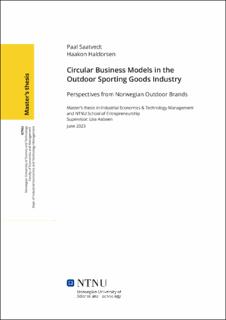| dc.contributor.advisor | Aaboen, Lise | |
| dc.contributor.author | Saatvedt, Paal | |
| dc.contributor.author | Haldorsen, Haakon | |
| dc.date.accessioned | 2023-10-05T17:21:32Z | |
| dc.date.available | 2023-10-05T17:21:32Z | |
| dc.date.issued | 2023 | |
| dc.identifier | no.ntnu:inspera:152978446:152981952 | |
| dc.identifier.uri | https://hdl.handle.net/11250/3094632 | |
| dc.description.abstract | Selskaper fra friluftsliv og sportsutstyrsindustrien blir ofte trukket frem som forløpere innen forskning på sirkulære forretningsmodeller (Bocken et al., 2016; Fuchs & Hovemann, 2022a, 2022c, 2022d). Litteraturen understreker at det å gå fra en lineær forretningsmodell og et “take, make, and waste system” til sirkulære forretningsmodeller er avgjørende for å lette presset på miljøet vårt og redusere overforbruk (Ellen-MacArthur-Foundation, 2015; Yang, 2022). Å inkludere sirkulære praksiser er et viktig skritt i riktig retning, og noen selskaper innen utendørs sportsutstyr har kommet langt på vei (Holtström et al., 2019; Rattalino, 2018). Det er imidlertid viktig å vurdere virkningen av disse praksisene for å identifisere bærekraftige sirkulære forretningsmuligheter på selskapets tredoble bunnlinje (Wiebe et al., 2023) og som i tillegg fører til et redusert forbruk (Tunn et al., 2019). Likevel er det utført begrensede studier på inkluderingen av sirkulære praksiser i friluftslivsbransjen og deres relasjon til bærekraft. For å adressere dette litteraturgapet har forfatterne svart på forskningsspørsmålet.
RQ: Hvordan inkluderer norske utendørssportmerker sirkulær praksis i sine forretningsmodeller, og hvordan relaterer praksisene til bærekraftige sirkulære forretningsmodeller?
En litteraturstudie og en kvalitativ flersaksstudie av fem norske utendørssportmerker ble utført for å svare på dette forskningsspørsmålet. Primær og sekundærdata ble samlet inn for sakene, hvor semistrukturerte intervjuer ble utført for å samle inn primærdataen. Terminologien til ressurssykluser fra (Bocken et al., 2016) og de teoretiske rammeverkene «Triple Bottom Line» (Wiebe et al., 2023) og «Sustainable Consumption» (Tunn et al., 2019) ble brukt for å strukturere funnene.
Funnene fra denne studien viste at praksisene knyttet til å sakte ned ressurssykluser, som utleie, reparasjon og videresalg, er de mest fremtredende innen utendørsmerkene og mest innflytelsesrike på den tredobbelte bunnlinjen og bærekraftig forbruk. Videre viser funnene at praksis knyttet til å lukke ressurssykluser er mindre fremtredende. Komplekse produkter og materialer gjør resirkuleringspraksiser utfordrende, og balansering av funksjonalitet og sirkularitet gjør bruk av resirkulerte materialer komplisert. Ytterligere forskning kan utforske perspektivene til flere interessenter, virkningen av handlingsplaner og forskrifter, forbrukeratferd og aksept, resirkuleringspraksiser og skalerbarheten til sirkulære praksiser. | |
| dc.description.abstract | Companies from the Outdoor Sporting Goods Industry are frequently brought forth as forerunners in the field of Circular Business Model research (Bocken et al., 2016; Fuchs & Hovemann, 2022a, 2022c, 2022d). The literature stresses that moving from a linear business model and the “take, make, and waste system” to circular business models is essential to ease the pressure on our environment and reduce overconsumption (Ellen-MacArthur-Foundation, 2015; Yang, 2022). Including circular practices is an important step, and some Outdoor Sporting Goods companies have come a long way in this field (Holtström et al., 2019; Rattalino, 2018). However, assessing the impact of these practices is essential to identify sustainable circular business opportunities on the company’s triple bottom line (Wiebe et al., 2023) and in what degree it reduces the overall consumption (Tunn et al., 2019). Nevertheless, limited studies have been conducted on including circular practices in the OSGI and their sustainability. To address this literature gap, the authors have answered the research question:
RQ: How do Norwegian outdoor sports brands include circular practices in their business models, and how do the practices relate to sustainable circular business models?
A literature review and a qualitative multiple-case study of five Norwegian outdoor sports brands were conducted to answer our research question. Primary and secondary data were collected for the cases, with semi-structured interviews being conducted to collect primary data. The terminology of Resource Cycles (Bocken et al., 2016) and the theoretical frameworks of the Triple Bottom Line (Wiebe et al., 2023) and Sustainable Consumption (Tunn et al., 2019) were used to structure the findings.
The findings of this study showed that practices related to the slowing resource loops, such as rental, repair, and resale, are the most prominent within the outdoor brands and most influential on the Triple Bottom Line and Sustainable Consumption. Furthermore, the findings show that the practices related to closing resource flows are less prominent within the OSGI. Complex products and materials make recycling practices challenging, and balancing functionality and circularity makes using recycled materials complex. Further research could explore the perspectives of Multiple Stakeholders, the impact of Action Plans and Regulations, Consumer Behavior and Acceptance, Recycling Practices, and the Scalability of Circular Practices. | |
| dc.language | eng | |
| dc.publisher | NTNU | |
| dc.title | Circular Business Models in the Outdoor Sporting Goods Industry:
Perspectives from Norwegian Outdoor Brands | |
| dc.type | Master thesis | |
